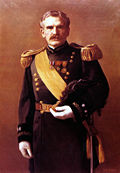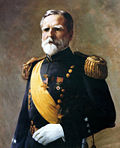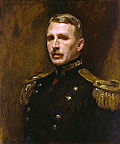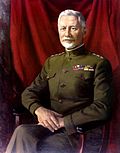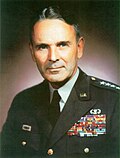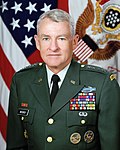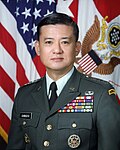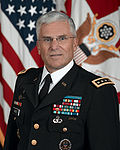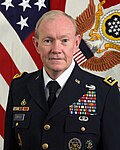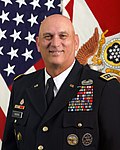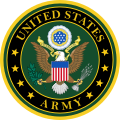| No. | Portrait | Name | Term | Branch | Secretaries served under: | Ref. |
|---|
| Took office | Left office | Duration | War / Army | Defense |
|---|
|
| 1 | | Young, Samuel Baldwin Marks Lieutenant General
Samuel B. M. Young
(1840–1924) | 15 August 1903 | 8 January 1904 | 146 days | Cavalry | Elihu Root | — | |
| 2 | | Chaffee, AdnaLieutenant General
Adna R. Chaffee
(1842–1914) | 9 January 1904 | 14 January 1906 | 2 years, 5 days | Cavalry | Elihu Root
William Howard Taft | — | |
| 3 | | Bates, JohnLieutenant General
John C. Bates
(1842–1919) | 15 January 1906 | 13 April 1906 | 89 days | Infantry | William Howard Taft | — | |
| 4 | | Bell, James Major General
J. Franklin Bell
(1856–1919) | 14 April 1906 | 21 April 1910 | 4 years, 7 days | Cavalry | William Howard Taft
Luke Edward Wright
Jacob M. Dickinson | — | |
| 5 | | Wood, LeonardMajor General
Leonard Wood
(1860–1927) | 22 April 1910 | 21 April 1914 | 3 years, 364 days | Medical and cavalry | Jacob M. Dickinson
Henry L. Stimson
Lindley Miller Garrison | — | |
| 6 | | Wotherspoon, WilliamMajor General
William W. Wotherspoon
(1850–1921) | 22 April 1914 | 16 November 1914 | 208 days | Infantry | Lindley Miller Garrison | — | |
| 7 | | Scott, HughMajor General
Hugh L. Scott
(1853–1934) | 17 November 1914 | 22 September 1917 | 2 years, 309 days | Cavalry | Lindley Miller Garrison
Newton D. Baker | — | |
| 8 | | Bliss, Tasker General
Tasker H. Bliss
(1853–1930) | 23 September 1917 | 19 May 1918 | 238 days | Field artillery | Newton D. Baker | — | |
| 9 | | March, PeytonGeneral
Peyton C. March
(1864–1955) | 20 May 1918 | 30 June 1921 | 3 years, 41 days | Field artillery | Newton D. Baker
John W. Weeks | — | |
| 10 | | Pershing, John General of the Armies
John J. Pershing
(1860–1948) | 1 July 1921 | 13 September 1924 | 3 years, 74 days | Cavalry | John W. Weeks | — | |
| 11 | | Hines, JohnMajor General
John L. Hines
(1868–1968) | 14 September 1924 | 20 November 1926 | 2 years, 68 days | Infantry | John W. Weeks
Dwight F. Davis | — | |
| 12 | | Summerall, CharlesGeneral
Charles P. Summerall
(1867–1955) | 21 November 1926 | 20 November 1930 | 3 years, 364 days | Infantry and artillery | Dwight F. Davis
James William Good
Patrick J. Hurley | — | |
| 13 | | MacArthur, DouglasGeneral
Douglas MacArthur
(1880–1964) | 21 November 1930 | 1 October 1935 | 4 years, 315 days | Infantry and engineers | Patrick J. Hurley
George Dern | — | |
| 14 | | Craig, MalinGeneral
Malin Craig
(1875–1945) | 2 October 1935 | 31 August 1939 | 3 years, 333 days | Infantry and cavalry | George Dern
Harry Hines Woodring | — | |
| 15 | | Marshall, George General of the Army
George C. Marshall
(1880–1959) | 1 September 1939 | 18 November 1945 | 6 years, 78 days | Infantry | Harry Hines Woodring
Henry L. Stimson
Robert P. Patterson | — | |
| 16 | | Eisenhower, DwightGeneral of the Army
Dwight D. Eisenhower
(1890–1969) | 19 November 1945 | 6 February 1948 | 2 years, 79 days | Infantry | Robert P. Patterson (of War)
Kenneth Claiborne Royall
(of War, 1947; of the Army, 1947–1949) | James Forrestal
(from Sep. 1947) | |
| 17 | | Bradley, OmarGeneral
Omar N. Bradley
(1893–1981) | 7 February 1948 | 15 August 1949 [a] | 1 year, 189 days | Infantry | Kenneth Claiborne Royall
Gordon Gray | James Forrestal
Louis A. Johnson | |
| 18 | | Collins, JosephGeneral
J. Lawton Collins
(1896–1987) | 16 August 1949 [b] | 14 August 1953 | 3 years, 363 days | Infantry | Gordon Gray
Frank Pace
Robert T. Stevens | Louis A. Johnson
George C. Marshall
Robert A. Lovett
Charles Erwin Wilson | |
| 19 | | Ridgway, MatthewGeneral
Matthew B. Ridgway
(1895–1993) | 15 August 1953 | 29 June 1955 | 1 year, 319 days | Infantry | Robert T. Stevens | Charles Erwin Wilson | |
| 20 | | Taylor, MaxwellGeneral
Maxwell D. Taylor
(1901–1987) | 30 June 1955 | 30 June 1959 [c] | 4 years, 0 days | Field artillery | Robert T. Stevens
Wilber M. Brucker | Charles Erwin Wilson
Neil H. McElroy | |
| 21 | | Lemnitzer, LymanGeneral
Lyman L. Lemnitzer
(1899–1988) | 1 July 1959 [b] | 30 September 1960 [a] | 1 year, 91 days | Infantry and coast artillery | Wilber M. Brucker | Neil H. McElroy
Thomas S. Gates Jr. | |
| 22 | | Decker, GeorgeGeneral
George H. Decker
(1902–1980) | 1 October 1960 [b] | 30 September 1962 | 1 year, 364 days | Infantry | Wilber M. Brucker
Elvis Stahr Jr.
Cyrus Vance | Thomas S. Gates Jr.
Robert McNamara | |
| 23 | | Wheeler, EarleGeneral
Earle G. Wheeler
(1908–1975) | 1 October 1962 | 2 July 1964 [a] | 1 year, 275 days | Infantry and armor | Cyrus Vance
Stephen Ailes | Robert McNamara | |
| 24 | | Johnson, HaroldGeneral
Harold K. Johnson
(1912–1983) | 3 July 1964 | 2 July 1968 | 3 years, 365 days | Infantry and cavalry | Stephen Ailes
Stanley Rogers Resor | Robert McNamara
Clark Clifford | |
| 25 | | Westmoreland, WilliamGeneral
William C. Westmoreland
(1914–2005) | 3 July 1968 | 30 June 1972 | 3 years, 363 days | Field artillery | Stanley Rogers Resor
Robert Froehlke | Clark Clifford
Melvin Laird | |
| – | | Palmer, BruceGeneral
Bruce Palmer Jr.
(1913–2000)
Acting
[d] | 1 July 1972 | 11 October 1972 | 102 days | Infantry and cavalry | Robert Froehlke | Melvin Laird | |
| 26 | | Abrams, CreightonGeneral
Creighton W. Abrams Jr.
(1914–1974) | 12 October 1972 | 4 September 1974 † | 1 year, 327 days | Armor | Robert Froehlke
Bo Callaway | Melvin Laird
Elliot Richardson
James R. Schlesinger | |
| – [d] | 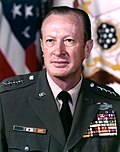 | General
Frederick C. Weyand
(1916–2010) | 5 September 1974 | 4 October 1974 | 29 days | Infantry and intelligence | Bo Callaway
Martin R. Hoffmann | James R. Schlesinger
Donald Rumsfeld | [5] [6] |
| 27 | 4 October 1974 | 30 September 1976 | 1 year, 362 days | |
|
| 28 | | Rogers, BernardGeneral
Bernard W. Rogers
(1921–2008)
[e] | 1 October 1976 | 21 June 1979 | 2 years, 263 days | Infantry | Martin R. Hoffmann
Clifford Alexander Jr. | Donald Rumsfeld
Harold Brown | |
| 29 | | Meyer, EdwardGeneral
Edward C. Meyer
(1928–2020) | 22 June 1979 | 21 June 1983 | 3 years, 364 days | Infantry | Clifford Alexander Jr.
John O. Marsh Jr. | Harold Brown
Caspar Weinberger | |
| 30 | | Wickham, JohnGeneral
John A. Wickham Jr.
(1928–2024) | 23 June 1983 [b] | 23 June 1987 | 4 years, 0 days | Infantry and cavalry | John O. Marsh Jr. | Caspar Weinberger | |
| 31 | | Vuono, CarlGeneral
Carl E. Vuono
(born 1934) | 23 June 1987 | 21 June 1991 | 3 years, 363 days | Field artillery | John O. Marsh Jr.
Michael P. W. Stone | Caspar Weinberger
Frank Carlucci
Dick Cheney | |
| 32 | | Sullivan, GordonGeneral
Gordon R. Sullivan
(1937–2024) | 21 June 1991 [b] | 20 June 1995 | 3 years, 364 days | Armor and mechanized infantry | Michael P. W. Stone
Togo D. West Jr. | Dick Cheney
Les Aspin
William J. Perry | |
| 33 | | Reimer, DennisGeneral
Dennis J. Reimer
(born 1939) | 20 June 1995 | 21 June 1999 | 4 years, 1 day | Artillery and mechanized infantry | Togo D. West Jr.
Louis Caldera | William J. Perry
William Cohen | |
| 34 | | Shinseki, EricGeneral
Eric K. Shinseki
(born 1942)
[f] | 21 June 1999 [b] | 11 June 2003 | 3 years, 355 days | Cavalry | Louis Caldera
Thomas E. White | William Cohen
Donald Rumsfeld | |
| – | | Keane, JohnGeneral
John M. Keane
(born 1943)
Acting
[d] | 11 June 2003 | 1 August 2003 | 51 days | Infantry | None [g] | Donald Rumsfeld | [7] |
| 35 | | Schoomaker, PeterGeneral
Peter J. Schoomaker
(born 1946)
[h] | 1 August 2003 | 10 April 2007 | 3 years, 252 days | Cavalry and Special Forces | Francis J. Harvey
Pete Geren | Donald Rumsfeld
Robert Gates | |
| 36 | | Casey, GeorgeGeneral
George W. Casey Jr.
(born 1948) | 10 April 2007 | 11 April 2011 | 4 years, 1 day | Armor and mechanized infantry | Pete Geren
John M. McHugh | Robert Gates | [8] |
| 37 | | Dempsey, MartinGeneral
Martin E. Dempsey
(born 1952) | 11 April 2011 | 7 September 2011 [a] | 149 days | Armor and armored
cavalry | John M. McHugh | Robert Gates
Leon Panetta | [9] |
| 38 | | Odierno, RaymondGeneral
Raymond T. Odierno
(1954–2021) | 7 September 2011 | 14 August 2015 | 3 years, 341 days | Field artillery | John M. McHugh | Leon Panetta
Chuck Hagel
Ash Carter | [10] |
| 39 | | Milley, MarkGeneral
Mark A. Milley
(born 1958) | 14 August 2015 | 9 August 2019 [a] | 3 years, 360 days | Armor and light infantry | John M. McHugh
Eric Fanning
Mark Esper
Ryan D. McCarthy | Ash Carter
Jim Mattis
Mark Esper | [11] |
| 40 | | McConville, JamesGeneral
James C. McConville
(born 1959) | 9 August 2019 [b] | 4 August 2023 | 3 years, 360 days | Aviation and cavalry | Ryan D. McCarthy
Christine Wormuth | Mark Esper
Lloyd Austin | [12] |
| – [d] |  | General
Randy A. George
(born 1964) | 4 August 2023 | 21 September 2023 | 48 days | Infantry | Christine Wormuth
Daniel P. Driscoll | Lloyd Austin
Pete Hegseth | [13] |
| 41 | 21 September 2023 | Incumbent | 2 years, 37 days | [14] |
|




